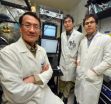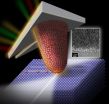(Press-News.org) This press release is available in German.
Up to now, it has been a case of "either/or." On the one hand, we have the typical ultra-compact, lightweight electric car, where designers have had to compromise on safety. With larger e-cars on the other hand, the heavier frames and crumple zones come at the expense of battery range. But now researchers as well as engineers from some of Germany's top technology firms are looking to create the best of both worlds. The aim of the Visio.M project is to develop a mobility concept for an efficient electric vehicle, making the design as light as possible while still delivering the best possible safety protection.
The Visio.M engineers decided in favor of an innovative monocoque body structure. Typically used in racing cars, a monocoque chassis combined with lightweight materials enables good stability while keeping overall weight to a minimum.
Innovative materials
The developers are also breaking new ground in their choice of ultra-lightweight materials for the structure: The passenger compartment will be made of carbon-fiber-reinforced plastic. Composite materials of this type are already used in the manufacture of aircraft and luxury sports cars. The downside is that they are extremely complex to produce and expensive as a result. So the Visio.M engineers intend to investigate the feasibility of carbon fiber materials in ultra-compact cars suitable for series production.
For the drive system, too, the Visio.M developers are looking to keep weight to an absolute minimum. The e-car they are designing will have an efficient and compact asynchronous electric engine. The transmission system will incorporate very light gears resting on hollow shafts. This would make the gears up to 15 percent lighter than conventional designs.
Safety first
The lightweight design innovations may be impressive, but driver and passenger safety is still the number one priority of the Visio.M project. The sturdy carbon fiber structure will incorporate various dedicated active and passive features addressing the specific safety challenges of an ultra-compact electric car. The ideas being investigated include specially adapted seatbelts as well as other innovative concepts to minimize potential injuries in the event of an accident. By the end of the project, the researchers hope that they will have achieved the maximum possible level of safety.
A research prototype vehicle has already passed some initial chassis tests. The Electronic Stability Program, i.e., the anti-lock braking system and the torque vectoring system, have been put through their paces at a test site near Munich – marking another successful step in the move to develop a safe electric vehicle.
INFORMATION:
Participants in the Visio.M consortium are, in addition to the automotive companies BMW AG (lead manager) and Daimler AG, the Technische Universität München as a scientific partner, and Autoliv BV & Co. KG, the Federal Highway Research Institute (BAST), Continental Automotive GmbH, E.ON AG, Finepower GmbH, Hyve AG, IAV GmbH, InnoZ GmbH, Intermap Technologies GmbH, LION Smart GmbH, Neumayer Tekfor Holding GmbH, Siemens AG, Texas Instruments Germany GmbH and TÜV SÜD AG as industrial partners. The project is funded, with 10.8 million euros over two and a half years, within the framework of the program IKT 2020 and the research focus area "Key Technologies for Electromobility – STROM" of the German Federal Ministry of Education and Research (BMBF).
www.visiom-automobile.de
Light yet safe contender for city streets
Visio.M project: Carbon fiber lightweight design for electric car
2013-01-30
ELSE PRESS RELEASES FROM THIS DATE:
How our cells cope with toxic small molecules
2013-01-30
In this week's issue of the prestigious journal Nature Chemical Biology, scientists Carole Linster (University of Luxembourg), Emile Van Schaftingen (Louvain University), and Andrew D. Hanson (University of Florida, Gainesville) review an important, but so far neglected, part of metabolism, namely metabolite damage-control. In their publication 'Metabolite damage and its repair or pre-emption', the authors present a comprehensive overview of the known reactions generating unwanted small molecules in the cell as well as of the corresponding control mechanisms, and discuss ...
How does fibrosis occur in Crohn's disease?
2013-01-30
New research has shown that a protein, known as IL-13, could be the key to the development of fibrosis in Crohn's disease. This breakthrough could help to advance new medicines to treat people suffering with the disease.
Crohn's disease is a chronic, debilitating condition characterised by inflammation and ulceration occurring at any point in the gastrointestinal tract. Currently there is no cure. One of the major complications of Crohn's disease is the development of fibrosis – hardening and thickening – in the bowel wall. This causes the intestine to lose its mobility ...
Academic gains, improved teacher relationships found among high risk kids in Head Start
2013-01-30
BEND, Ore. – A new study by Oregon State University researchers finds that Head Start can make a positive impact in the lives of some of its highest risk children, both academically and behaviorally.
Published in the current issue of the Journal of Applied Developmental Psychology, the study sheds light on how Head Start has helped children living in non-parental care, or living with someone who is not a parent or step-parent by biology or adoption.
"These children tend to have unstable home lives, sometimes transitioning between different relatives, living with their ...
Snails signal a humid Mediterranean
2013-01-30
An international team of researchers has shown that old wives' tales that snails can tell us about the weather should not be dismissed too hastily.
While the story goes that if a snail climbs a plant or post, rain is coming, research led by the University of York goes one better: it shows snails can provide a wealth of information about the prevailing weather conditions thousands of years ago.
The researchers, including scientists from the Scottish Universities Environmental Research Centre (SUERC), analysed the chemistry of snail shells dating back 9,000 to 2,500 years ...
Scientists learn more about how inhibitory brain cells get excited
2013-01-30
AUGUSTA, Ga. – Scientists have found an early step in how the brain's inhibitory cells get excited.
A natural balance of excitement and inhibition keeps the brain from firing electrical impulses randomly and excessively, resulting in problems such as schizophrenia and seizures. However excitement is required to put on the brakes.
"When the inhibitory neuron is excited, its job is to suppress whatever activity it touches," said Dr. Lin Mei, Director of the Institute of Molecular Medicine and Genetics at the Medical College of Georgia at Georgia Regents University ...
A new genre of 'intelligent' micro- and nanomotors
2013-01-30
Enzymes, workhorse molecules of life that underpin almost every biological process, may have a new role as "intelligent" micro- and nanomotors with applications in medicine, engineering and other fields. That's the topic of a report in the Journal of the American Chemical Society, showing that single molecules of common enzymes can generate enough force to cause movement in specific directions.
Peter J. Butler, Ayusman Sen and colleagues point out that enzymes — proteins that jump-start chemical reactions — are the basis of natural biological motors essential to life. ...
Penn research shows mechanism behind wear at the atomic scale
2013-01-30
PHILADELPHIA — Wear is a fact of life. As surfaces rub against one another, they break down and lose their original shape. With less material to start with and functionality that often depends critically on shape and surface structure, wear affects nanoscale objects more strongly than it does their macroscale counterparts.
Worse, the mechanisms behind wear processes are better understood for things like car engines than nanotech devices. But now, researchers at the University of Pennsylvania's School of Engineering and Applied Science have experimentally demonstrated ...
Researchers improve medical units to reduce nursing fatigue, cut costs
2013-01-30
ITHACA, N.Y. – In hospitals, poor floor design, storage closet clutter and crowded corridors can contribute to nurse and medical staff fatigue. These distractions can hurt patient care quality and result in higher medical costs.
Now, a new Cornell University study offers a spatial solution.
Rana Zadeh, Cornell assistant professor of design and environmental analysis in the College of Human Ecology, analyzed the floor plans and work patterns within five medical-surgical units at U.S. hospitals and found numerous opportunities to boost nurses' efficiency through better ...
Conflicting cultural identities may foster political radicalism
2013-01-30
New research suggests that dual-identity immigrants — first-generation immigrants and their descendants who identify with both their cultural minority group and the society they now live in — may be more prone to political radicalism if they perceive their two cultural identities to be incompatible.
The new research is published in Psychological Science, a journal of the Association for Psychological Science.
Psychological scientist Bernd Simon from Kiel University in Germany and colleagues hypothesized that perceived incompatibility between the two cultural identities ...
Aging cells lose their grip on DNA rogues
2013-01-30
PROVIDENCE, R.I. [Brown University] — Even in our DNA there is no refuge from rogues that prey on the elderly. Parasitic strands of genetic material called transposable elements — transposons — lurk in our chromosomes, poised to wreak genomic havoc. Cells have evolved ways to defend themselves, but in a new study, Brown University researchers describe how cells lose this ability as they age, possibly resulting in a decline in their function and health.
Barbara McClintock, awarded the Nobel Prize in 1983, made the original discovery of transposons in maize. Since then ...
LAST 30 PRESS RELEASES:
Interaction of climate change and human activity and its impact on plant diversity in Qinghai-Tibet plateau
From addressing uncertainty to national strategy: an interpretation of Professor Lim Siong Guan’s views
Clinical trials on AI language model use in digestive healthcare
Scientists improve robotic visual–inertial trajectory localization accuracy using cross-modal interaction and selection techniques
Correlation between cancer cachexia and immune-related adverse events in HCC
Human adipose tissue: a new source for functional organoids
Metro lines double as freight highways during off-peak hours, Beijing study shows
Biomedical functions and applications of nanomaterials in tumor diagnosis and treatment: perspectives from ophthalmic oncology
3D imaging unveils how passivation improves perovskite solar cell performance
Enriching framework Al sites in 8-membered rings of Cu-SSZ-39 zeolite to enhance low-temperature ammonia selective catalytic reduction performance
AI-powered RNA drug development: a new frontier in therapeutics
Decoupling the HOR enhancement on PtRu: Dynamically matching interfacial water to reaction coordinates
Sulfur isn’t poisonous when it synergistically acts with phosphine in olefins hydroformylation
URI researchers uncover molecular mechanisms behind speciation in corals
Chitin based carbon aerogel offers a cleaner way to store thermal energy
Tracing hidden sources of nitrate pollution in rapidly changing rural urban landscapes
Viruses on plastic pollution may quietly accelerate the spread of antibiotic resistance
Three UH Rainbow Babies & Children’s faculty elected to prestigious American Pediatric Society
Tunnel resilience models unveiled to aid post-earthquake recovery
Satellite communication systems: the future of 5G/6G connectivity
Space computing power networks: a new frontier for satellite technologies
Experiments advance potential of protein that makes hydrogen sulfide as a therapeutic target for Alzheimer’s disease
Examining private equity’s role in fertility care
Current Molecular Pharmacology achieves a landmark: real-time CiteScore advances to 7.2
Skeletal muscle epigenetic clocks developed using postmortem tissue from an Asian population
Estimating unemployment rates with social media data
Climate policies can backfire by eroding “green” values, study finds
Too much screen time too soon? A*STAR study links infant screen exposure to brain changes and teen anxiety
Global psychiatry mourns Professor Dan Stein, visionary who transformed mental health science across Africa and beyond
KIST develops eco-friendly palladium recovery technology to safeguard resource security
[Press-News.org] Light yet safe contender for city streetsVisio.M project: Carbon fiber lightweight design for electric car




